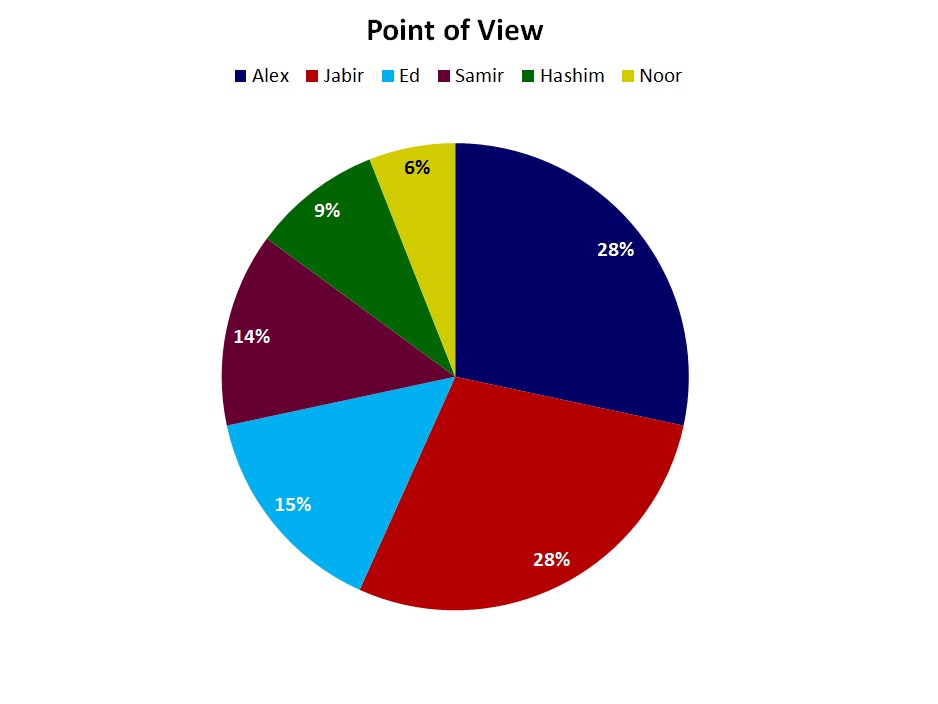Numbers in Writing: Point of View
 In writing good fiction, point of view (POV) can make or break a novel. I won’t delve into the details and technicalities associated POV. Instead, check out Characters, Emotion & Viewpoint by Nancy Kress for more details on POV.
In writing good fiction, point of view (POV) can make or break a novel. I won’t delve into the details and technicalities associated POV. Instead, check out Characters, Emotion & Viewpoint by Nancy Kress for more details on POV.
I want to examine how numbers related to POV can improve a novel. Note that this analysis works only for third-person POV with multiple points of view.
How does looking at numbers for POV work? Take a look at the percentage of scenes devoted to the POV of each character.
- It provides balance. A novel with using multiple third-person POVs shouldn’t lean heavily in favor of one major character over another. For example, in the figure shown, Alex and Jabir are the two main characters. You can see that both have approximately the same percentage of scenes from their POV. The same goes, to a lesser extent, for the remaining characters.
- It shows POV scene percentages. Major characters need more POV scenes than minor characters since the plot revolves around their story. Supporting characters may get some scene time but to a lesser extent. Last, minor characters may get scenes in their POV if the writer sees no other way to advance the plot. On the figure above, Alex and Jabir have the greatest percentage of scenes in their POV. Ed is an antagonist, and Samir is another character in a more supporting role. They get the second greatest time. Finally, Noor and Hashim are both minor characters. They get the least amount of scenes in their POV.
To determine POV percentages, take the following steps:
- Take the previous spreadsheet you used for intensity and list the POV for each scene. For more help on developing the spreadsheet, feel free to contact me.
- Graph these into a pie chart like what you see on the figure. Include all POVs, not just those of the main characters.
- Examine the pie chart. Do your main characters get enough scenes from their POV? Have you balanced the scenes so that they’re roughly equal POV splits for each character? Keep in mind that they don’t have to be precisely equal. Do beware that a minor character doesn’t become a camera hog and steal all of the scenes. If so, then perhaps he’s not as minor as you thought.
- Take what you’ve learned from the pie chart and revise your novel. Maybe your protagonist hasn’t gotten enough scenes from her POV. Revise a scene from her leading man’s POV and make it from hers. Maybe a minor character has too many scenes from his POV. If so, consider cutting a scene, revising it to a more major character’s POV, or expanding his role so that he becomes more of a major character.
There you have it. Numbers can play into POV in a big way. Ensuring adequate scenes from different POVs and balancing them go a long way in creating a better novel.
Question: What are some other ways numbers could help with POV in revising a novel?
I have not received any compensation for writing this post. I have no material connection to the brands, products, or services I have mentioned. I am disclosing this in accordance with the Federal Trade Commission’s 16 CFR Part 255: Guides Concerning the Use of Endorsements and Testimonials in Advertising.”




No Comments